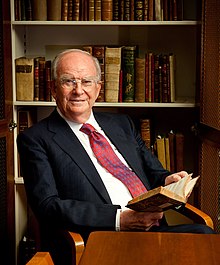John Meurig Thomas
Sir John Meurig Thomas (born December 15, 1932 ) is a leading British chemist in the fields of heterogeneous catalysis , solid-state chemistry , materials science and surface chemistry . Thomas has authored over a thousand scientific articles and several books. He has received numerous awards and honorary doctorates. In 1991 he was promoted to Knight Bachelor ("Sir") for "services to chemistry and the popularization of science" . The mineral meurigite is named after him. Much of his research focuses on new heterogeneous catalysts and tries to understand the structure and mode of operation of existing systems using techniques such as X-ray absorption spectroscopy , nuclear magnetic resonance spectroscopy, and high resolution transmission electron microscopy . He is one of the most cited authors in the field of heterogeneous catalysis. In the last few years he has focused his research on the development of "green" catalysts for new technologies and on the development of possibilities for studying catalysts under reaction conditions.
life and work
Thomas was born near the Welsh mining town of Llanelli , South Wales . He studied chemistry at the University of Wales , Swansea , where he received his PhD in the group of Keble Sykes . After graduating, he worked briefly for the UK Atomic Energy Agency before embarking on a scientific career at the Department of Chemistry at the University of Wales. He was able to show that defects and other structural disturbances on surfaces affect the electronic structures.
In 1969 he became a professor at Aberystwyth University , where he put his research focus on the study of surfaces and materials science. He also researched the application of electron microscopy in chemistry. In 1977 he was elected a Fellow of the Royal Society . Between 1979 and 1986 Sir John was Director of the Institute of Physical Chemistry and Professorial Fellow at King's College, where he continued to develop new techniques in solid-state chemistry. Another branch was the development of new materials and the design of new catalysts. He expanded his early electron microscopic investigations to include intercalation compounds and minerals. He investigated zeolite materials using techniques such as solid-state NMR, neutron scattering and real-space methods.
In 1986 he succeeded Sir George Porter as Director of the Royal Institution of Great Britain , London . In 1987 he and David Phillips gave the prestigious Christmas lecture at the Royal Institution (Crystals and Lasers). His research focus shifted to the investigation of active centers under reaction conditions. He also synthesized new nano- and mesoporous materials and molecular sieves . He resigned from this post in 1991 because of his wife's health problems. After a short stint at the University of Wales, he went back to Cambridge , where he became a Master of Peterhouse, the oldest college in Cambridge, in 1993.
Thomas holds 25 patents and developed a solvent-free, catalytic process for the production of ethyl acetate and caprolactam .
Thomas has received twenty honorary doctorates from Australian, British, Canadian, Chinese, Dutch, Egyptian, French, Italian, Japanese, Spanish and US universities. He is also an honorary member of more than fifteen foreign academies, including the American Philosophical Society , the American Academy of Arts and Sciences , the Accademia dei Lincei (Rome) and the Russian Academy of Sciences .
His most recent awards include the Royal Medal (2016), the Blaise Pascal Medal of the European Academy of Sciences (2014), the Bragg Price teaching assignment from the British Association Crystallographic (2010), the Sven Berggren Prize Lectureship, Lund (2010) , the Ertl Prize teaching assignment from the Max Planck Society (2010), the Sir George Stokes Gold Medal from the Royal Society of Chemistry (2005), the Giulio Natta Gold Medal from the Società Chimica Italiana (2004), the Linus Pauling Gold Medal from Stanford University (2003) and the American Chemical Society Annual Award for Creative Research in Heterogeneous and Homogeneous Catalysis (1999). He has the Davy Medal of the Royal Society and the Faradayvorlesung and the associated price and the Corday-Morgan Medal of the Royal Society of Chemistry won. In 1995 he became the first British scientist in 80 years to receive the Willard Gibbs Gold Medal from the American Chemical Society. In 1995, in recognition of his contributions to geochemistry, the International Mineralogical Association named a new mineral, Meurigite, after him.
Together with Gábor A. Somorjai and Norbert Kruse , John M. Thomas publishes the magazine Catalysis Letters .
Individual evidence
- ↑ John Meurig Thomas: A Breakthrough in Electron Microscopy. In: Angewandte Chemie. 117, 2005, pp. 5699-5702, doi: 10.1002 / anie.200501466 .
- ^ Paul A. Midgley, Matthew Weyland, John Meurig Thomas, Brian FG Johnson: Z-Contrast tomography: a technique in three-dimensional nanostructural analysis based on Rutherford scattering. In: Chemical Communications. , Pp. 907-908, doi: 10.1039 / B101819C .
- ↑ Single-Site Heterogeneous Catalysts (PDF; 202 kB), by John Meurig Thomas, Robert Rajac and Dewi W. Lewis
Web links
- Prof. Thomas's homepage at Cambridge University, with a list of publications and a résumé.
- Fullerian Professorships
- John Meurig Thomas in an interview with Alan Macfarlane on November 29 and December 5, 2007 (film)
| personal data | |
|---|---|
| SURNAME | Thomas, John Meurig |
| BRIEF DESCRIPTION | British chemist |
| DATE OF BIRTH | December 15, 1932 |
